The French consul takes us to the consulate of Congo in Franceville, and applying for a visa when he sits next to us becomes much easier: the usual requirements and the 15-day limitation for the Congolese visa instantly disappear. We just have to hand in the photocopies we brought with us, and tell the Congolese consul how many days we want to stay. For 30’000 CFA, we pick our 45-day visa three hours later, very happy. The visa even reads “Address: camping“! It is a good revenge on the “proof of hotel reservation” condition. Visa applications can be a real pain, but when you get the chance, no holds are barred. The Congolese consulate in Franceville is facing the Hôtel Masuku, just before reaching the golden statue of Omar Bongo.
Apparently, the Gabonese, as well as the Senegalese and probably others, could visit France without a visa until Schengen was put in place. Since then, it became harder for some African nationals to visit Europe, and the “principle of reciprocity” makes it difficult for French citizens to visit francophone countries. Well, I say “difficult”, but it still must be easier than the other way around.

As our host has been living in the area for decades, he knows a lot. There is much more to learn with a local than by cycling on our own. Well, it is not really History, but small stories. For example, which minister or which big boss built this large house, where the French expats used to work and have lunch, etc. The Bongo family is from Franceville area, from a small town with a large stadium and an olympic village now called Bongoville. As a result, many of Gabon’s nominated high ranking officials come from the region. We get a guided tour of Franceville and pay a visit to the CIRMF, the Centre International de Recherches Medicales de Franceville, that Sarkozy visited in 2010. Unfortunately, it is not a suitable time of the day to see the remarkable colonies of primates. Dangerous viruses are also kept in the center. We will take more pictures when we return to Franceville with the bicycles …
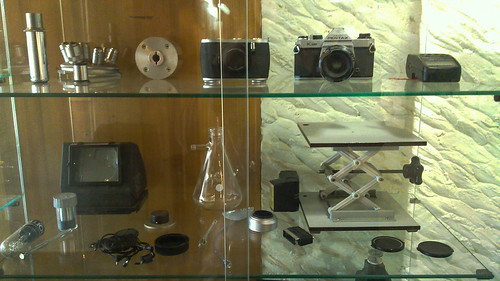
The city of Moanda is alive thanks to the Manganese mining. The ore is used to make strengthened steel alloys, for military purposes for example. The mining company, Comilog (Compagnie des Mines de l’Ogooué) is the world’s second largest producer. It started with the independence of Gabon and is still running, now owned by Eramet, the same French group that exploits (less successfully) nickel in New Caledonia.
When the mine started, there was no easy way to carry the manganese out of the bush until the Gabonese coast for shipping. The solution adopted was to build a cableway through Bakoumba until the Congolese border at Mbinda. There, the ore was loaded onto trains, and transported until Pointe-Noire by the Congo Ocean railway. The cableway was at this time the longest in the world: imagine tons of ore transported on a cable, hanging in the air at up to 74 meters, over 76 kilometers of bush. There is almost nothing left to see, but the channel cleared in the forest is still visible on satellite pictures, parallel to the zigzagging road. The satellite view also illustrates how bad Google Maps is in Africa, as it drew the road in place of the cableway.
The cableway was decommissioned when the railway became operational 20 years ago. We had seen SETRAG stations in Otoumbi, Ayem and Lopé in the Lopé National Park. The railway was originally state-owned, but following its poor management, it became first operated by Comilog, and later owned by Comilog.
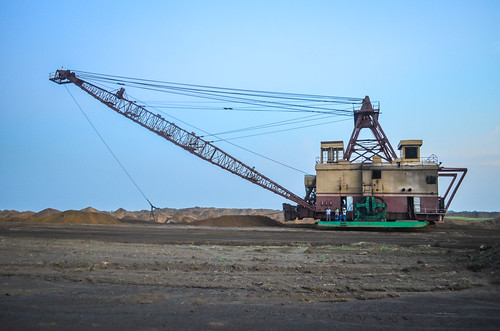
The mine produces 2 million tons annually, but it will be soon be increased to 4 millions, so as to supply to the Chinese who are already building plants in the area. Our host takes us for a short tour on the mine. The whole plateau above the town of Moanda is being dug.

We also enjoy stories about how Bongo senior use to rule the county. He was treating it like a big village, drinking a lot (despite being “Muslim”), and handing all serious issues over to the French Ambassador. With the oil, timber, uranium and manganese industry in a country of 1.5 million people (and it was only half a million in 1960), he used to visit towns and villages and offer suitcases full of cash. In the past, it was possible to collect the pensions of family members who already passed away, if a son showed up with the ID. In other words, the country was run very badly, but since there was a lot of money flowing to the Gabonese, nobody complained. Those stories suit both comments that I had heard earlier, “Gabonese are paid to do nothing” and “No, we don’t get paid by the government”.
It also explains why so many people complain that “we don’t have money, life is so much harder now, etc“. When Ali Bongo came to power in 2009, he stopped all those funny irregularities. In other words, now the Gabonese have to work to earn money. Well, considering the abundance of resources, I guess it should be possible to run the country in such a way, so that nationals could just watch the foreigners at work.
Apparently, Omar Bongo converted to Islam in 1973 in preparation of the integration of Gabon in the OPEC in 1975. It withdrew in 1995. His former name was Albert-Bernard Bongo. Similary, Ali Bongo was born Alain Bongo.
The hospitality of the consul and his stories were highly enjoyable, but we now have a Congolese visa in hands and must resume the cycling. There are various routes to reach Congo from Moanda: the first option is the road via Bakoumba, along the former manganese cableway, under construction by the Chinese. The second option is via Franceville and Boumango, and it is currently the best road according to the Congolese consul, with border posts operating neatly. The third option is to go through Lekoni and the Plateaux Batéké, but it lands in the Congolese bush north of Brazzaville. The Chinese have recently paved this road that used to be feared by overlanders.
We follow the recommendation that seems the most reliable. As usual, asking “how is the road?” to ten people will bring ten different answers, so we must sometimes stop the planning and jump on the saddle.
We cycle back to Franceville, after having done the same road with a 4×4. We don’t mind because this road has many sights.

It seems that half of the city of Moanda is made of cités Comilog, to house the workers. With electricity and health centers, via the 1500 employees, the sole mine may be providing a living to the whole town. Everyone here has a relative working for Comilog. The company is thus one of the first employers of Gabon.

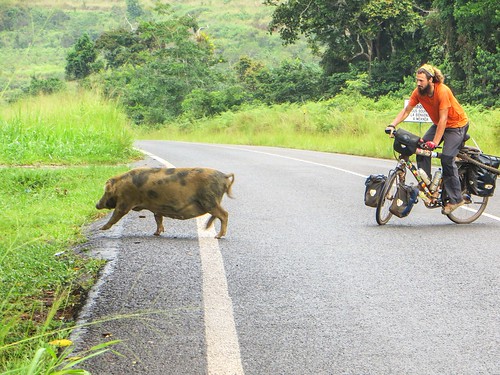

We reach the Moyabi international radio station that cannot be missed from the road.

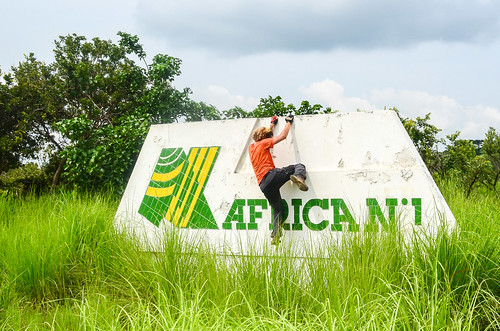
Africa °1 is a major radio in Africa. The site in Moyabi was set up in 1979 with 4 x 500 kW transmitters. Since then, it has been upgraded and has brocasted several programs of RFI (France), NHK (Japan), and more international stations. The full story is here.
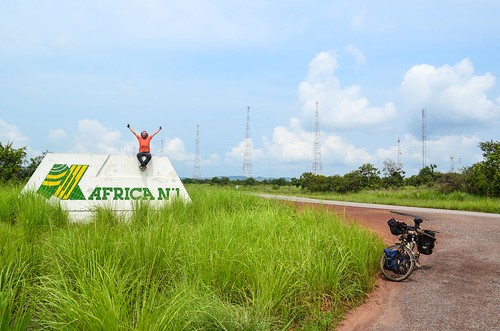
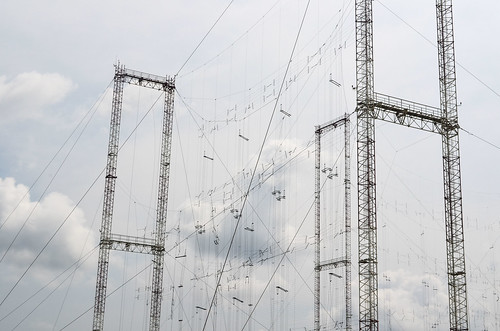
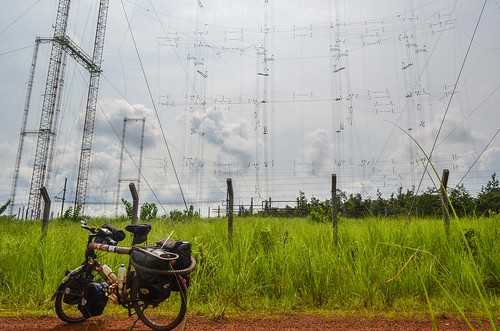
The consul had told us that gorillas were sometimes spotted around the transmitters, and that a French expat used to manage the whole station. We leave the main road to explore the vicinity of the transmitters but spot no gorillas, only locals working in the fields. There must be a guard or an engineer somewhere to explain how is this intriguing mesh working …
By the way, until now, I thought the only way to see gorillas was in Uganda, with the popular gorilla trek, where you have to pay 500 USD for the permit only. But Gabon and Congo also host gorillas and it must be much cheaper, although less advertised, around here.
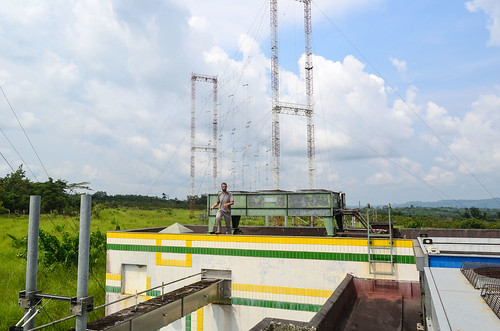
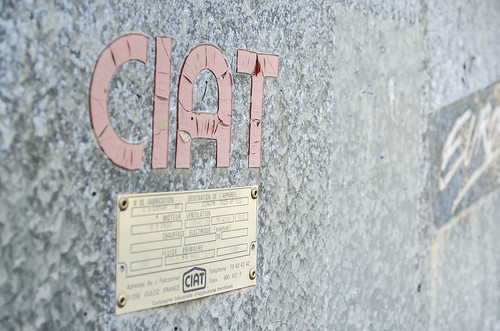
The transmitters are very high and they always look very close. But they aren’t, and the road leading to them is not obvious at all. We finally reach the offices, protected by a military. He says we can enter and ask questions to the people inside.
We enter the site but spot no one. Really no one. It should be forbidden to walk in and photograph military or strategic installations, but here, we are allowed. We can’t ask questions to anyone so we only roam around.

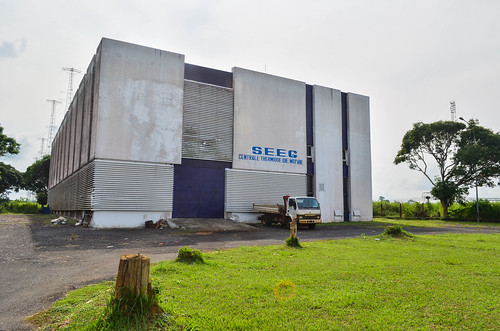
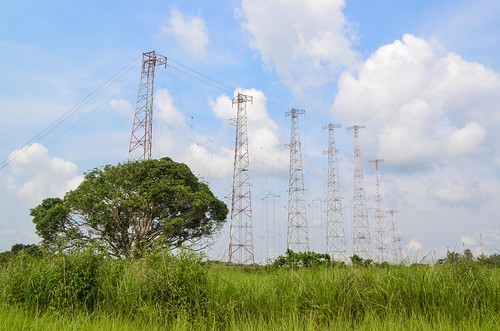

As usual, it is hard to get any food on the way. Our attempt to make a break with a Coca-Cola ends up with palm wine. This country is perfect for drivers fueled with alcohol.
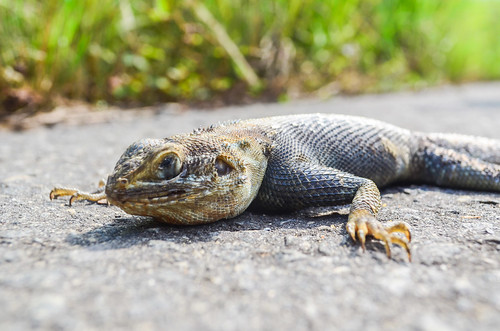
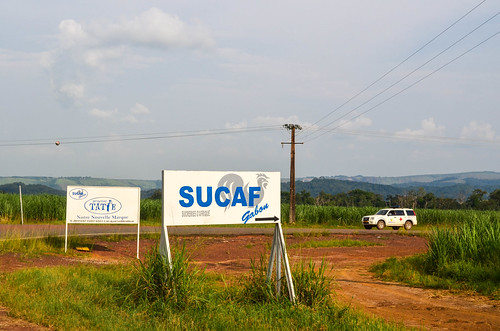
It appears that SUCAF Gabon is part of a larger French-based agri-food company, SOMDIAA, itself owned by … the Castel group, the same ones who run almost every brewery in francophone Africa.

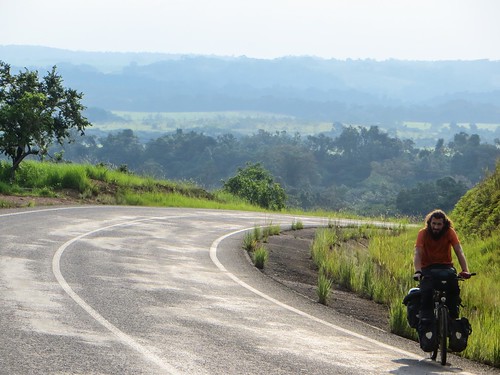
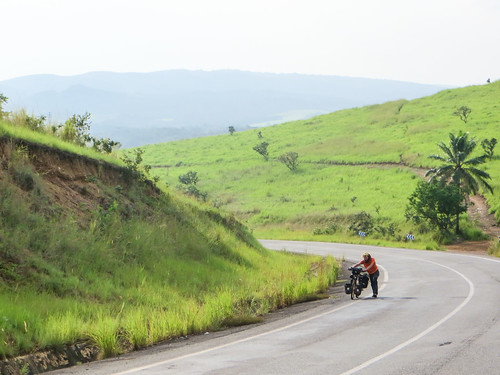
We ride entirely on the plateau of Franceville. Despite the covered sky, I am drowning in my own sweat and I dream of a jacuzzi of cold water.

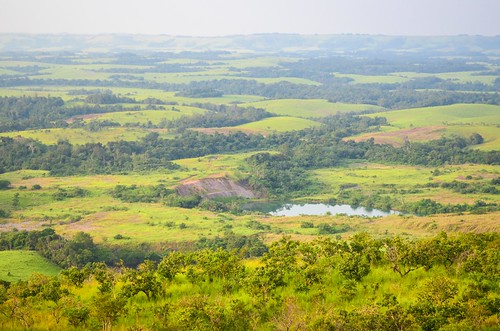
The landscape on the way to Franceville is stunning. It is very rare to see something different from the jungle. We are rolling on hills and finally enjoy views in the distance.
Another sight of the road is the Gabonese airforce base n°2. The first one is in Libreville. We heard many times that the French military is posted there, and even met a retired paratrooper who used to train with the French army. The history of this second one was explained to us by the consul.

In short, Africa not only suffered from the first world war and the second one, but even the cold war impacted the continent. After the wave of independence in the 1960’s, several young nations have taken the path of communism. Among them, the Republic of Congo, neighbor of Gabon.
As a result, Mirage fighter aircraft and French pilots were posted in Franceville. Currently, they are operated by South Africans. From the road, we can also spot afar a large radar that used to follow the Soviet MIGs flying from Congo.
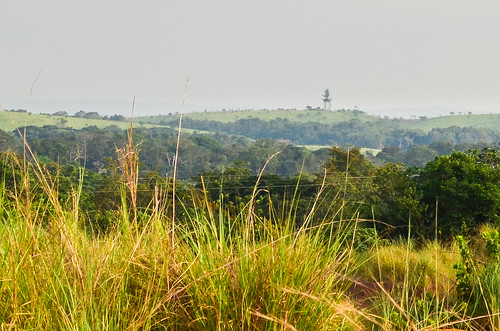
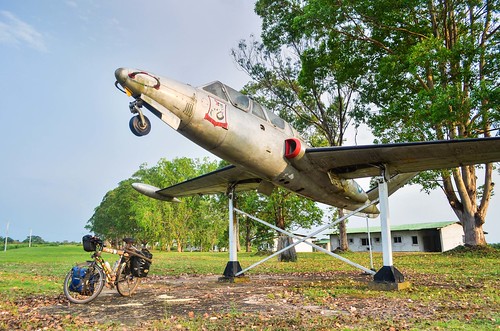
It is getting night and we barely have the time to explore another site along the road. There is a quarry where traces of prehistoric activity have been highlighted.


We arrive in Franceville at night. We have been there during the day, but it is now unrecognizable. The city is very spread out on several hills. We cycle for an hour in the streets up and down before settling down in a hotel.
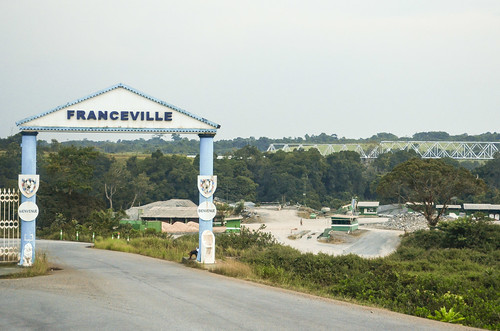
Franceville, the third city of Gabon, was founded in 1880 by Pierre Savorgnan de Brazza on a town called Masuku. Brazza is the same one who gave his name to the Mount Brazza in the Lopé National Park and obviously to Brazzaville, the capital of Congo. It is a charming administrative city on several hills, and it takes us 15 kilometers to photo-tour it in the morning.

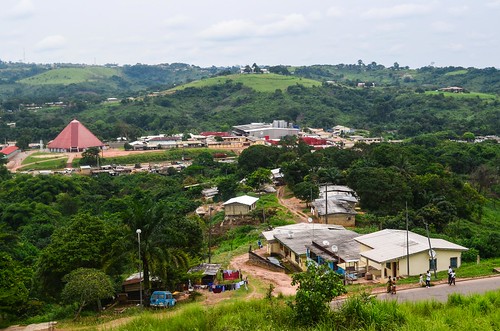
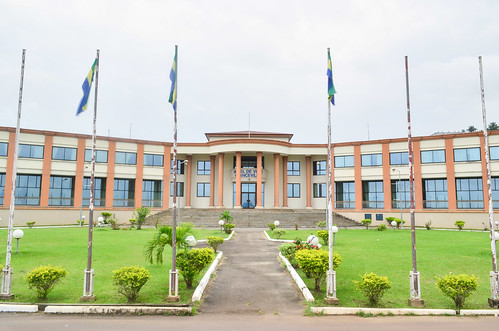

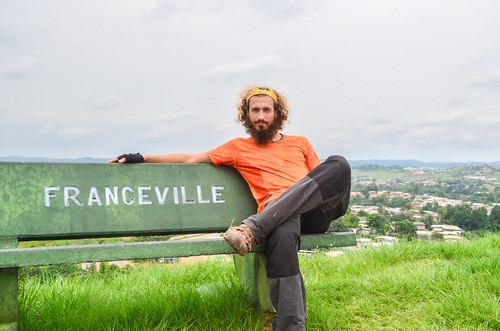
Brazza has statues of himself in Franceville, just like Omar Bongo.
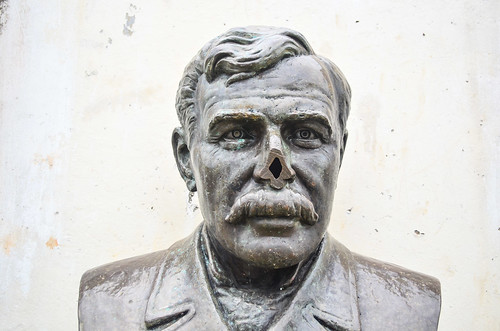
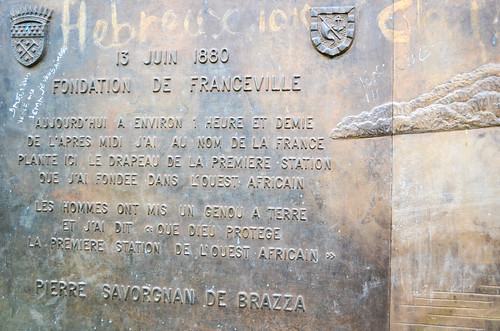
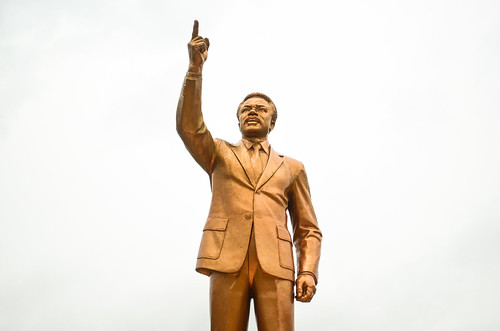
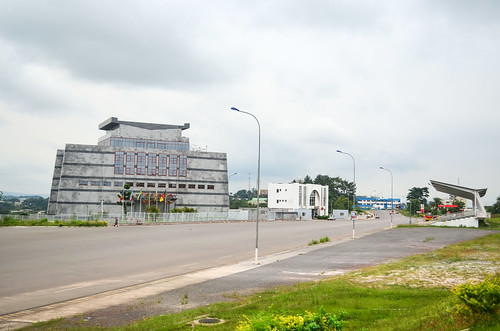
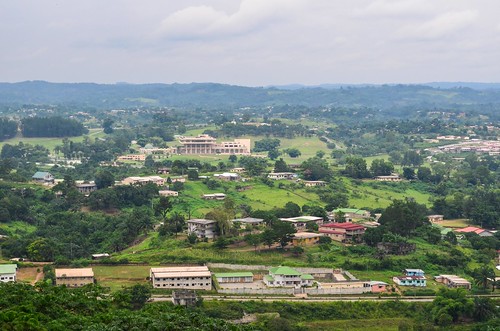
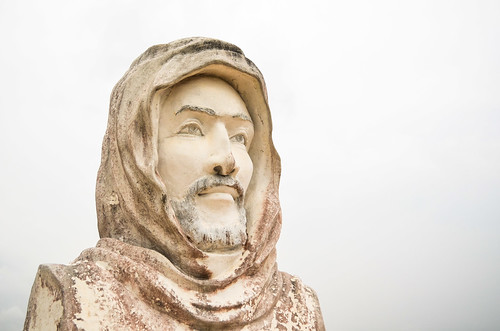
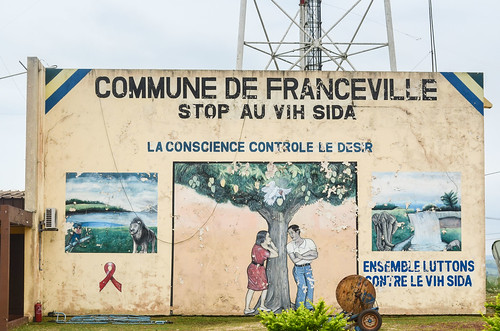
There is no doubt Franceville has money. The CAN 2012 (Africa Cup of Nations), won by Zambia, was hosted in Equatorial Guinea and Gabon, and Franceville stadium was one of the four venues. More recently in December 2013, Gabon won the CEMAC cup here.
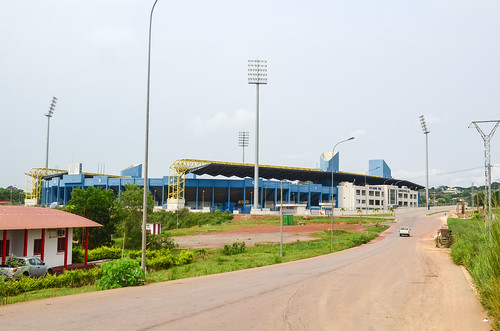
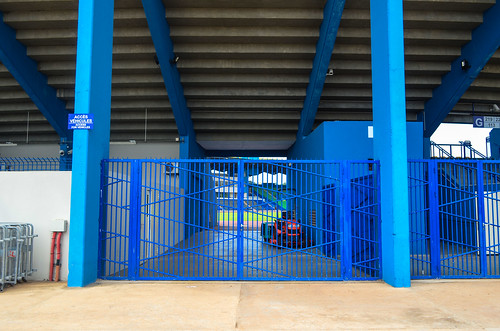

Next to the brand new stadium is found the railway terminus. The TransGabonais train from Libreville (Owendo) stops its journey here. Rumors say the line may be extended further north, until a huge iron ore deposit granted to the Chinese, or that the Chinese would duplicate the existing line.
The train is operated by Bolloré Africa Logistics, another French company enjoying a quasi-monopoly in Africa: the company, active in 46 African countries, operates 15 container terminals and 11 dry ports. Thus, the list is long, but basically, every container terminal on the West coast between Dakar (Senegal) and Luanda (Angola) is in the hands of the same people. Not only francophone ports, but also Freetown, Tema (Accra), and Lagos are concerned.

I saw Bouygues signboards somewhere else too … But as soon as we pass the stadium, the asphalt disappears and we are on a very long dirt road until the middle of Congo.

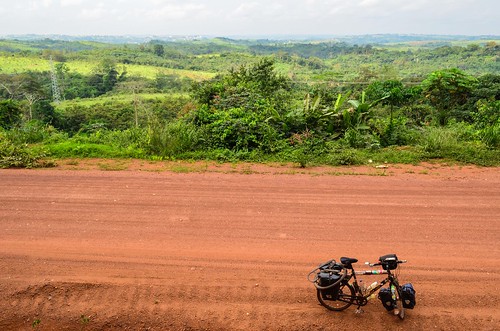
Apart from sweating a lot, nothing much is happening on the piste. A villager asks us “Are you the rally?“. The rally? How can we be a rally? “The Paris-Dakar rally came here some years ago. There was an accident nearby, it was on purpose, someone parked a minibus just where the race was happening. The driver died“. I didn’t believe it at first, as Gabon is not really between Paris and Dakar. But the story is true: in 1992, the rally went until Cape Town. The contestants left Libreville for Pointe-Noire in a single day, and it will take us around 10 days for the same journey. The story of the accident is also true (Paris – Cape Town 2012 details).
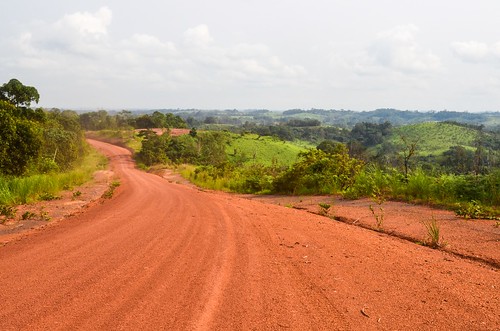
At the end of the day, we are caught by a thunderstorm and we reach the first village under the rain. There was nothing else than the bush, we saw no villages for 10 or 20 kilometers, not any pedestrian and one car only. The villagers of Ndzaki ville host us, and surprisingly, there is electricity along this road.
In the evening, we watch (once again) a Nigerian soap on TV, while a rat coming from the ceiling comes over the TV. He chases mosquitoes and big moths, competing with the geckos. These moths are huge, and they are more numerous outside the house:
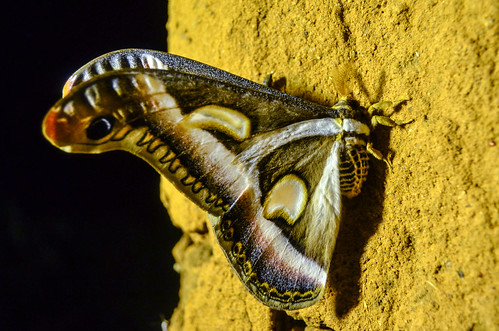

It rained all night and my clothes are still wet. The wet dirt road made of gravel and mud feels a bit sticky. In addition, the covered sky is not motivating today …
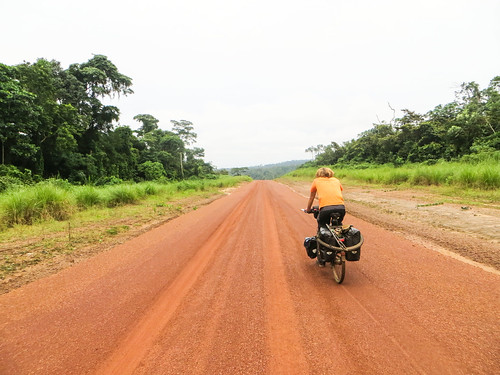
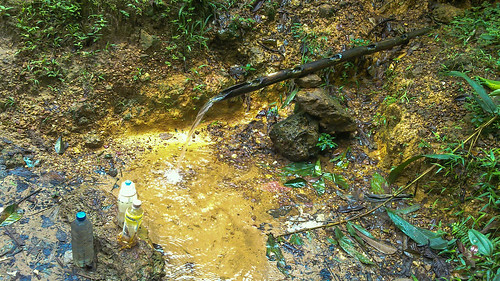
Some villagers tell us another story that explains why life is much harder now. Electricity works here with prepaid counters: just like for prepaid cellphones, individuals must buy a coupon and enter the code in their electrical counter, to be allowed a certain consumption. It allows the provider to distribute electricity without fearing the unpaid bills.
Before, with Bongo senior, those electricity coupons were distributed in the villages. Now, with Ali, people have to buy them.
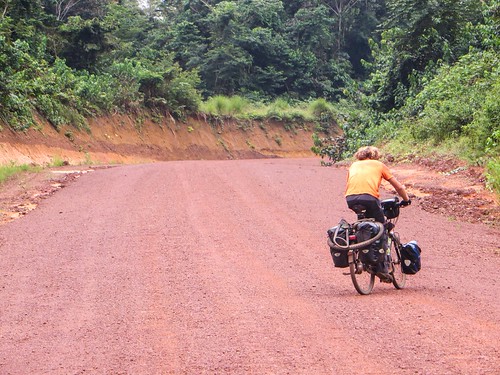
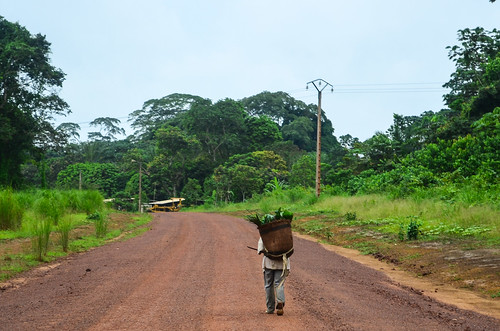
We stop in Boumango, the “end” of the road. After this, it is Congo. There are still 17 kilometers between Boumango and the official border, but the immigration post is here. There are three shops in the town, out of which two are run by Chadian brothers. There is no restaurant, no Cameroonian mama serving food, … so we will not spend a New Year’s Eve gastronomically more satisfying than Christmas …
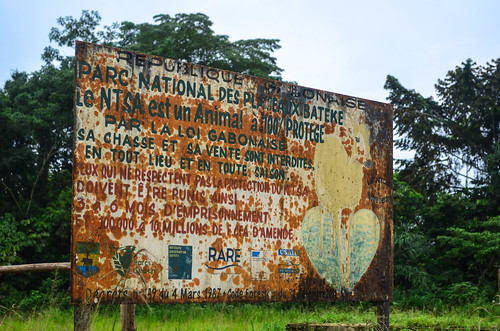
While sitting at the Chadian’s and eating his delicious bread, 4 small baguettes each, we catch up on the news with France24. It talks about a coup in Kinshasa … happening right now! Kinshasa, the DR Congo capital, is located right across the Congo river from Brazzaville. I hope there won’t be any troubles in Congo …
What is sure now is that my options for the route to Cape Town are being limited. Before starting the journey, I knew that taking the West Coast of Africa would lead me until the dilemma of DR Congo and Angola. I have to cross one of them, at least. Both are not particularly safe, but especially, both don’t like tourists and make their visa application a real challenge. Because the visa for Angola was said to be impossible to get, I thought I would go through DR Congo. Now that I know it is possible to get an Angolan visa in Pointe-Noire, I think I will stick with this idea.
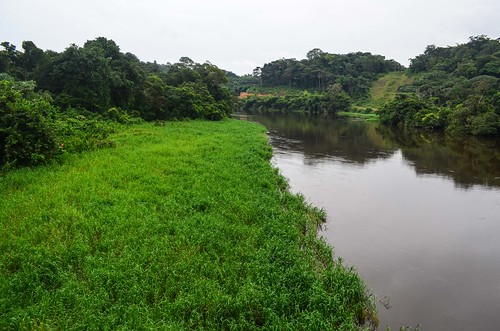
There is no accomodation in Boumango: the motel has no vacancy because road workers are renting it completely. Another lady has rooms for rent, but they have not been used in months because there is no one really visiting the village. We end up chatting with someone who might have a solution for us. He is actually the president of the conseil général and he is renting villas. One of them is rented to Australian mine workers doing iron ore exploration in the region. They are back to Australia for the year-end festivities, and the president is renting us their villa during their absence …
Boumango is strange. It has a new stadium, but no football team. It has a high voltage electricity line, deserving the whole road since Franceville, benefiting to 3000 inhabitants only. Gabon is indeed full of money, but it seems it could be used in a much smarter way …

At the bar, a young man is telling us about how hard is life in Gabon. He says he must get together with the family to gether 600 or 700 CFA so that he can buy a Régab beer. In the same time, he is surprised we don’t watch National Geographic and Ciné something channels. “You don’t know Ciné something? How is it possible? Wait … who makes the technology, White people right? Then how come you don’t know those channnels?“. Definitely, it is a problem if everyone think that all the Whites own everything that has been created by the Whites. I reply that “yes, we make the technology indeed, but we don’t have the petrol to buy it for ourselves“. This man knows about TV channels because he subscribed to a satellite TV excellence package for 75’000 CFA (115 €) a month.
He adds that New Year is generally spent in family. That is why he is back to his village, while his wife and his baby are going to the wife’s village.
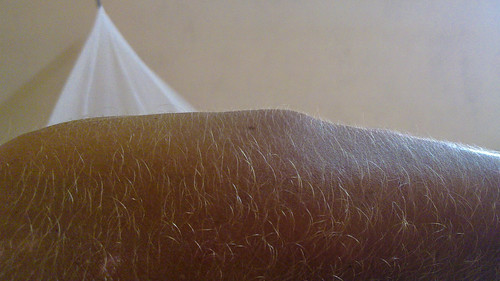
The good surprise in our New Year villa is that we (can) have hot water! There is a boiler, and a good conjunction of improbable events: electricity and water pressure at the same time. My last hot shower was in Bamenda, one month and a half ago. Here, I use the free time off cycling to catch up a bit on picture processing.

Finally, our New Year Eve dinner cooked with my petrol stove is mashed potatoes. There is no way to eat out in Boumango, but there are enough beers. We visit the bar just after the rain stops and just before midnight. We don’t seem to attract much attention. In general, and comparatively to most of the other countries, in Gabon the Whites are left alone easily, we don’t get as much shouting and hassling as elsewhere.
There is a policeman drinking and smoking in the bar, but he seems to be also working as a policeman in the same time. Fortunately he has no weapons, but it is funny when he asks for free beers, and in the same time he severely tells boys to behave. Everybody drinks but no one is doing the countdown. I don’t know we missed it already or if there is no countdown … The policeman says that we will soon celebrate New Year, which would mean that the celebration is at 1am? But at 00:59, one minute before the special moment, he realizes that his watch is one hour late, and that he missed the New Year too. On this note, and especially on the voices of the very loud girls, we enter the year 2014 …







Definitely, it is a problem if everyone thinks that all the Whites own everything that has been created by the Whites
Hello Jb
You really are acute here and we all should know the why to the outcome, As the way I see it that isolation and distance turns to separateness and ignorance either both sides south and north hemisphere .